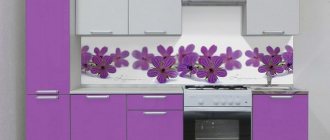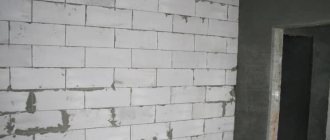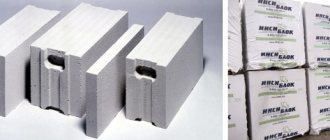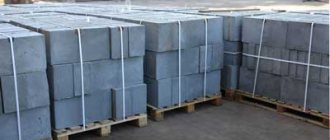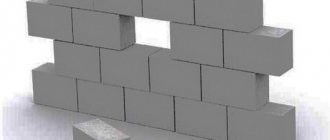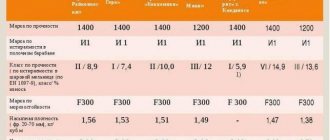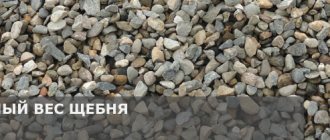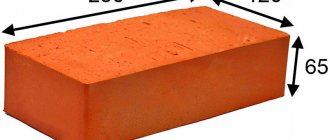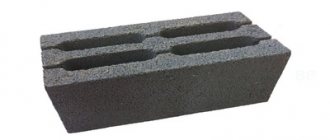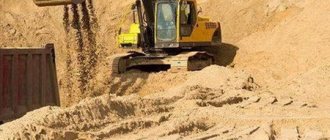Concrete blocks are used to construct residential buildings or outbuildings. They have many advantages, primarily their relatively low weight and high level of thermal insulation. Often, during a purchase, there is a need to calculate how many foam blocks are in a cube. The answer to this question is important in order to purchase the required amount of building material. If there are errors in the calculations, situations may arise with a shortage or excess of material, which in any case will lead to financial losses.
Products from different manufacturers differ in size and purpose Source nevdom.ru
How to correctly calculate the number of units
Most manufacturers produce products in different shapes and sizes. The cost of building material is determined per 1 m3. Products with dimensions of 20x30x60 cm are considered the most popular. There is a need to find out how many blocks are in a 300x200x600 foam block cube. The volume of one product is calculated using the formula: length multiplied by width and height. If you make calculations, you can easily determine the volume of one standard product. It is equal to 0.036 m3. If 1 m3 is divided by 0.036 m3, the result will be 27.78. Using this method, they calculate how many blocks are in a cube.
The number of units in one cube depends on the size of the block Source stroy-podskazka.ru
See also: Catalog of block house projects
Deciding on the thickness of the wall
With one more quantity required to accurately calculate the purchase volume, the calculations are more complicated.
To find out the thickness of the wall, it is necessary to take into account both the strength and thermal insulation, which are sufficient to ensure the reliability and comfort of the building.
If we calculate the thickness of an external wall with D600 blocks, which in a dry state have a thermal conductivity coefficient λ = 0.14 Kcal/m2, for a wall with thermal resistance R = 3.14, then working with the formula R = d/λ we obtain d - wall thickness, equal to 0.45 meters, if we take into account the maximum possible frosts up to -40 degrees below zero.
It is not worth building a thinner wall, even if the area proposed for construction does not have such frosts. The fact is that foam blocks gain moisture, while their thermal conductivity decreases, and the calculation data changes upward.
For internal load-bearing walls, the thickness may be less, for ordinary internal walls - even less.
Usually external walls are made in 2 layers. Knowing how many pieces of foam blocks 200x300x600 are in 1m3, the quantity is calculated only for external walls. For internal ones, the size 100x300x600 is used. The presence and size of window and door openings are taken into account.
Number of blocks in a pallet
Packages for transportation can have different volumes and sizes. Often there is a need to find out how many blocks are in a pallet. To do this, first of all, find out the number of products in 1 m3. If you examine the pallet, you can see how many units there are on each side of the package. Using this data, you can find out how many foam blocks are in the pallet. Since many manufacturers often change the dimensions of pallets, the quantity may vary.
The dimensions of the block directly affect the number of units required to build a house Source static.tildacdn.com
Calculations for the number of blocks in one pallet are made based on their sizes. One cubic meter is divided by the volume of one product. Once you know how many aerated concrete blocks are in 1 m3, it is easy to calculate the number of units in the package.
Pallet features
Each manufacturer uses different sized pallets. Standard wooden packaging has a width of 800 and a length of 1000 mm, Euro pallets - 800x1200, model "FIN" - 1000x1200. This type of container is subject to increased quality requirements, which are regulated by GOST. Defects are completely excluded, since the guarantee of transportation and safety of the goods depends on this.
There are also generally accepted recommendations for stacking blocks on pallets for shipment. Stone is placed on Euro pallets 2 units long and 4 units wide. A standard pallet holds 2 blocks long and 5 blocks wide. The number of rows in both cases is the same - 5. The stone is laid using the “cross-ligation” or “one-on-one” technology.
Knowing everything about the features of the container, it is not difficult to calculate the number of blocks on a wooden platform. If we take the above data for calculations, then a Euro pallet can hold 40 pieces (2x4x5) or 1.44 cubic meters. m. (40x0.36), and a standard container fits 50 blocks (2x5x5) or 1.8 cubic meters. m. (50x0.36).
How to calculate the required number of blocks per house
First of all, measure the length, height and thickness of each wall. These data are multiplied and the volume of building material is determined. It is divided into the volume of a separate block from which the wall will be built. The result is an approximate number of units needed for construction. It is necessary to add 5 to 10% excess to it.
It is necessary to make exact dimensions of all walls Source m-strana.ru
Classification by brand
The number of aerated concrete blocks and their weight can be determined based on their brand. It is designated by the letter D and a number that corresponds to the density of the material. The higher the grade, the stronger the aerated concrete blocks, but the worse their thermal insulation characteristics.
According to this indicator, aerated concrete is divided into the following types:
- D300–D Thermal insulation material used for laying partitions in frame houses;
- D600–D Structural and thermal insulating material, suitable for the construction of load-bearing structures;
- D1000–D Structural aerated concrete blocks, often requiring additional insulation.
Features of transportation of building materials
Before construction begins, the blocks must be delivered to the site. During transportation, special attention is paid to the integrity and preservation of the properties of the cargo. Aerated concrete is a rather fragile material that can be damaged when loading or unloading vehicles. Pallets must be loaded in one row with a distance of 5 cm between them to avoid collisions. Packages must be securely secured using straps made of soft material. The speed of freight transport should not exceed 70 km/h on an asphalt road and 40 km/h on a road with poor quality. Soft ropes are used for unloading. The unloading itself is done using a crane, one pallet at a time.
Compliance with all requirements during transportation allows you to maintain the quality of the building material Source storage.bloxy.ru
Information on the purpose of the calculator
Online foam block calculator
designed to calculate the number and parameters of foam concrete blocks for the construction of walls of residential buildings and non-residential premises, as well as other structures, taking into account gables, window and door openings. Calculation of the amount of associated materials, such as the amount of sand-cement mortar, masonry mesh and the cost of materials.
When filling out the data, pay attention to the additional information with the Additional information sign
Foam concrete blocks are one of the types of cellular concrete, which contain, in addition to water, cement and sand, a chemical foaming agent. It is thanks to the foaming agent that this material is light and has sufficient strength to resist external loads. The structure of concrete itself, as well as in aerated blocks, is cellular, containing many closed air pores that are evenly distributed throughout the entire volume.
Foam concrete is a fairly popular building material and is used in all main types of construction, such as:
- Block construction of walls
- Monolithic filling
- Use as a heat and sound insulating material
The strength of such concrete depends on its density; the higher the density, the higher the strength. But this rule only works if all standards are observed during the production process. The quality of the material depends on the type of production. The production process is quite simple, which is why this material has gained high fame and popularity even in sparsely populated areas. But in this case, this was a big disadvantage, since the possibility of production in “garage” conditions has the worst impact on quality.
Large enterprises use special foam generators and high-pressure autoclave chambers, in which foam concrete gains its strength while maintaining a uniform distribution of air pores throughout the entire volume. Unfortunately, many small enterprises produce foam concrete blocks without such chambers, and also neglect many other rules (inaccurate calculation of raw materials, small amounts of cement, cheap foaming agents, violation of drying conditions, homemade equipment). In this regard, the resulting concrete has a clearly uneven density, which is why it does not meet accepted standards and declared characteristics. Over time, such foam blocks develop cracks of various sizes, delaminate and crumble.
Attempts to save on building materials lead to partial (and sometimes complete) destruction of the integrity of the structure after just a few years.
The mechanical strength of foam concrete, due to its porous structure, is quite low compared to conventional concrete. In this regard, the use of this material is possible only in walls that do not bear significant loads. As well as the mandatory presence of reinforcing belts above the upper rows, even when constructing wooden floors.
Despite this, foam concrete has a number of significant advantages compared to many other types of heavy concrete:
- Low thermal conductivity
- Low volumetric weight
- Ease of machining
– but provided it is dry.
– significantly reducing labor costs, as well as the possibility of using more simplified foundations.
– there is no need for special equipment for sawing and drilling.
Buy foam blocks only from large enterprises that have a full production cycle that meets all standards, and also have certificates of compliance with GOST.
The following is a complete list of calculations performed with a brief description of each item. If you haven't found the answer to your question, you can contact us via feedback.
Options
Structural parts with densities D900 and D1200 are characterized by high strength and weight. Thermal insulation elements D500-900 are used in the construction of 3-story buildings with walls laid in 1 layer.
Thermal insulation products of the D400 and D500 brands are used when arranging partitions inside structures. Aerated concrete blocks differ in configuration. The walls are laid from standard type products, and reinforced beams made of foam concrete are used to construct the ceilings.
Such products are durable, reliable in operation, and designed for maximum permissible loads. Installation of floors is carried out from T-shaped structures with parameters 600x250x200 mm. Technological and design developments of manufacturers are aimed at facilitating construction.
An excellent solution are special blocks with an arcuate configuration. Formwork is made from hh type products along the outer contour.
[my_custom_ad_shortcode2]
Weight
A cube of aerated concrete with a density of 600 kg/m³ weighs 23.4 kg. Checking the weight upon receipt of the shipment allows you to compare the calculated data with the figures indicated in the accompanying documents. A block measuring 60x30x20 cm with a density of 500 kg/m³ weighs 18 kg, 60x30x25 - 22.5 kg. A product with parameters 60x30x20 cm with a density of 700 kg/m³ - 25 kg, 60x30x25 cm - 32 kg.
If the weight of the pallet differs from the value established by the standards, this indicates low quality of the blocks and a violation of the production technology.
[my_custom_ad_shortcode6]
Cost of aerated concrete blocks
If we are talking about the financial part of construction, it is worth noting that the cost of one masonry element is also simply calculated based on the cost of one cubic meter of aerated concrete. And vice versa, having data on the cost of one element, it is easy to find out how much a cube of aerated concrete costs.
For example, one cubic meter of blocks with standard dimensions 100*625*250 mm costs 2900 rubles.
Let's calculate how much each element will cost us:
- Let's calculate the volume of the masonry unit: 0.1 x 0.625 x 0.25 = 0.015625 m3.
- Let's find out the number of stones in m3: 1 / 0.015625 = 64 pcs.
- Based on all the necessary data, we determine what the price of one block will be: 2900 / 64 = 45.3125 rubles. We round up and get - one element with dimensions 100 * 625 * 250 mm costs 45.32 rubles. This is the average estimated cost.
You should purchase products only from reliable suppliers who will not hide split or cracked products in the center of the pallet.
For your information! The final cost of the product will be significantly affected by the total amount of material that you decide to order. The location where the blocks are produced also matters.
Density
This indicator is proportional to the grade of concrete. Each type of building element is used to lay structures with different loads. In order not to make a mistake when choosing a brand, you should familiarize yourself with their purpose. Aerated concrete D600 is characterized by high strength.
Monoliths are erected from D500 blocks, D 400 - for arranging insulation when installing openings. Products made from aerated concrete D350, which has high porosity and a loose structure, are used primarily for heat insulation.
The material absorbs moisture, so a moisture-insulating soil ball is applied to the walls. The block manufacturing technology involves mixing the ingredients, which, when interacting, form a porous structure. High-density building elements have more weight.
How much aerated concrete in a cube can be determined by the density of the block. This indicator is designated D, and the numbers after the letter marking indicate the density value. A low index value corresponds to the presence of a large number of air pores, which increase heat conductivity.
The strength index of the D400 gas block is 45% higher than that of D300, but the thermal conductivity is 30% lower. The price of building products of the D400, 200, 300, 600 cm brand in Moscow and other regions is lower than for similar products of higher density.
Currently reading: Concrete grade M450, class B35.
[my_custom_ad_shortcode1]
